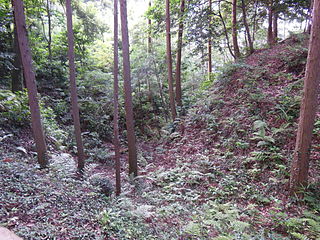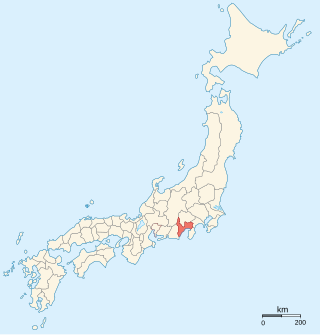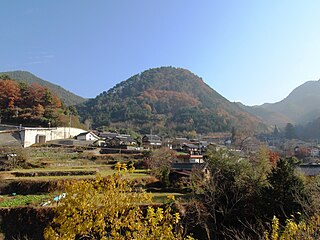
Tokugawa Ieyasu was the founder and first shōgun of the Tokugawa shogunate of Japan, which ruled from 1603 until the Meiji Restoration in 1868. He was one of the three "Great Unifiers" of Japan, along with his former lord Oda Nobunaga and fellow Oda subordinate Toyotomi Hideyoshi. The son of a minor daimyo, Ieyasu once lived as a hostage under daimyo Imagawa Yoshimoto on behalf of his father. He later succeeded as daimyo after his father's death, serving as ally, vassal, and general of the Oda clan, and building up his strength under Oda Nobunaga.

Imagawa Yoshimoto was a Japanese daimyō of the Sengoku period. Based in Suruga Province, he was known as The number one Daimyō in the Tōkaidō; he was one of the three daimyō that dominated the Tōkaidō region. He died in 1560 while marching to Kyoto to become Shogun. He was killed in the village of Dengakuhazama in Okehazama by Oda Nobunaga.

Takeda Shingen was daimyo of Kai Province during the Sengoku period of Japan. Known as the "Tiger of Kai", he was one of the most powerful daimyo of the late Sengoku period, and credited with exceptional military prestige. Shingen was based in a poor area with little arable land and no access to the sea, but he became one of Japan's leading daimyo. His skills are highly esteemed and on par with Mōri Motonari.

Nagashino Castle was a Sengoku period Japanese castle located in what is now Shinshiro, eastern Aichi Prefecture, Japan. It is noteworthy as the site of the crucial Battle of Nagashino between the combined forces of Tokugawa Ieyasu and Oda Nobunaga against Takeda Katsuyori in 1575. The ruins have been protected as a National Historic Site since 1929, the first time a former castle site had received such protection.

Noda Castle was a Sengoku period castle located in eastern Mikawa Province in what is today part of the city of Shinshiro, Aichi Prefecture, Japan.

Suruga Province was an old province in the area that is today the central part of Shizuoka Prefecture. Suruga bordered on Izu, Kai, Sagami, Shinano, and Tōtōmi provinces; and was bordered by the Pacific Ocean through Suruga Bay to the south. Its abbreviated form name was Sunshū (駿州).

Imagawa Ujizane was a Japanese daimyō who lived in the Sengoku period through the early Edo period. He was the tenth head of the Imagawa clan and was a son of Imagawa Yoshimoto and the father of Imagawa Norimochi and Shinagawa Takahisa.

Imagawa clan was a Japanese samurai clan that claimed descent from the Seiwa Genji by way of the Kawachi Genji. It was a branch of the Minamoto clan by the Ashikaga clan.

Takeda Nobutora was a Japanese daimyō who controlled the Province of Kai, and fought in a number of battles of the Sengoku period. He was the father and predecessor of the famous Takeda Shingen.

Hōjō Ujimasa was the fourth head of the later Hōjō clan, and daimyō of Odawara. Ujimasa succeeded the territory expansion policy from his father, Hojo Ujiyasu, and achieved the biggest territory in the clan's history.
Sessai Chōrō (雪斎長老) or Imagawa Sessai, also known as Taigen Sessai (太原雪斎), was a Japanese abbot and mountain ascetic (yamabushi). He was an uncle of Imagawa Yoshimoto, and served him as military advisor and as commander of Imagawa's forces, despite his lack of any formal battle training or experience.

Hōjō Ujiyasu was a daimyō (warlord) and third head of the Odawara Hōjō clan. Known as the "Lion of Sagami", he was revered as a fearsome samurai and a cunning man. He is famous for his strategies of breaking the siege from Takeda Shingen and Uesugi Kenshin. A son of Hōjō Ujitsuna, his only known wife was Imagawa Yoshimoto's sister, Zuikei-in. Among his sons are Hōjō Ujimasa and Uesugi Kagetora.
The second siege of Takatenjin came only six years after Takeda Katsuyori took the fortress. This second siege lasted from 1580 until 22 March 1581, the siege ended within four months and ended with the deaths of 680 of Okabe Motonobu/Naganori's garrison.

Hamamatsu Castle is a hirayama-style Japanese castle ruin, with some replica castle buildings. It was the seat of various fudai daimyō who ruled over Hamamatsu Domain, Tōtōmi Province, in what is now central Hamamatsu, Shizuoka Prefecture, Japan under the Edo period Tokugawa shogunate. It is also called Shusse Castle.

Yōgaiyama Castle was a Sengoku period yamajiro located in Kai Province, constructed in the 1520s by the Takeda clan. Since 1991, the ruins have been protected as a National Historic Site since 1938. The castle is also known as the Sekisuiyama Castle

Takatenjin Castle was a Sengoku period yamashiro-style Japanese castle located in the Kamihijikata and Shimohijikata neighborhoods of the city of Kakegawa, Shizuoka prefecture. The ruins have been protected as a National Historic Site since 1975, with the area under protection extended in 2007.

Lady Hayakawa was a Japanese aristocrat of the Sengoku period. Hayakawa is a common nickname for one of Daimyō Hōjō Ujiyasu's daughters, who lived in the Sengoku through early Edo periods. She is best known for marrying into the Imagawa clan as a condition for The Kōsōsun Triple Alliance, an alliance which put daughters of the Takeda, Imagawa and Hojo clans into political marriages. The formation of the alliance would later change the fate of these three powerful clans.

Myōki (妙喜) or Myokini (妙喜尼) was a Japanese female warrior (Onna-musha) from the Sengoku period. She was the daughter of Tōyama Naokage and wife of Suwabe Sadakatsu. Myōki was best known for defending Hio castle in Musashi Province against the Takeda clan attack.
Otazu no kata, Otatsu no kata or Iio Tazu, was a late-Sengoku period onna-musha. She was the wife of Iio Tsuratatsu and retainer of Imagawa clan. When the Imagawa fell into disarray after their defeat at Battle of Okehazama, she turned against them and became leader of the Iio clan after Tsuratatsu's death.

Futamata Castle was a Japanese castle located in Toyoda county of Tōtōmi Province, in what is now part of Tenryū-ku in the city of Hamamatsu, Shizuoka Prefecture, Japan. It was built in the Sengoku period and is noted as the site of the death of Tokugawa Ieyasu's son Matsudaira Nobuyasu in 1579. In 2018, the ruins were recognized as a National Historic Site together with adjacent Tobayama Castle.
















